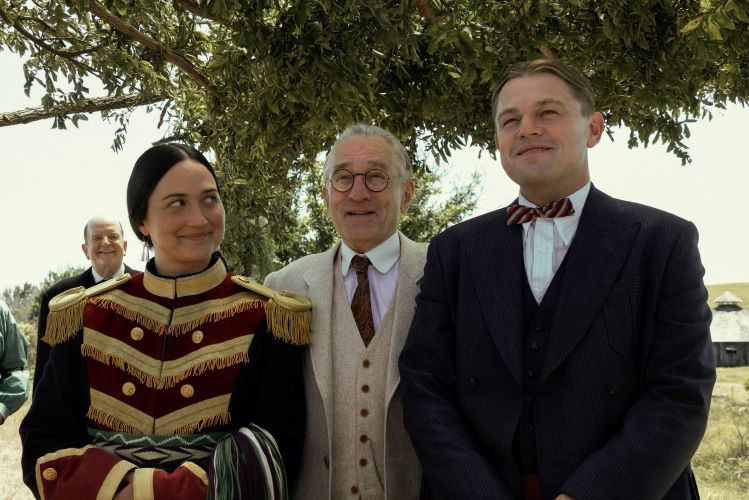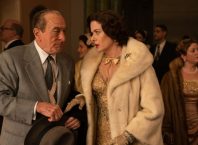
In Killers of the Flower Moon, Martin Scorsese has created a moving American epic that exposes the violence and injustice in the history of the nation, telling a gripping tale of systemic discrimination, greed, and murder. The film is based on true events, with a screenplay by Eric Roth and Scorsese adapted from the 2017 nonfiction book by journalist David Grann – Killers of the Flower Moon: The Osage Murders and the Birth of the FBI. A crime thriller in which the villains are made known from the start, the strength of Scorsese’s film is in its depiction of character, with Robert De Niro as the notoriously manipulative William King Hale, and Leonardo DiCaprio as his nephew and accomplice Ernest Burkhart. The beating heart of this horrific narrative is its reverence and sensitivity to the plight of the Osage people, which finds its expression in an outstanding performance by Lily Gladstone (Certain Women), who portrays an Osage woman, Mollie Kyle, with honesty, courage, and warmth, creating a memorable, heroic character.
The film is set in an era known as the “Reign of Terror,” from about 1918 to 1931, when over 60 unsolved murders and suspicious deaths of Osage people were reported. Forced by the United States government to move from their traditional lands to Oklahoma, the Osage discovered oil on their new lands, and because the agreement with the government granted them the mineral rights to the land, they became incredibly wealthy. This twist of fate is depicted in the film’s opening scenes, that begins with a traditional Osage pipe ritual, and merges into the oil gushing up from the ground, followed by black and white archival-like stills of Osage people in elegant clothing standing by their fancy cars. In addition to supplying the background to the ensuing events, these first images reflect some of the tension between the Osage Native American culture and the surrounding, oppressive, White culture. Although they now possessed wealth, the Osage were still living under the rule of the conquering culture, which required the Osage to have White guardians to approve all their financial decisions. When Mollie Kyle comes to the bank to make a withdrawal from her account, she introduces herself – as she must – as “incompetent,” which is her legal status. Yet she looks the banker in the eye and speaks with a serene dignity and authority that belies the truth of that label. The requirement of guardianship paved the way for greedy, unscrupulous White people to get their hands on the Osage money. But it gets worse.
One ought to be suspicious of any person who wants to be called King, and Robert De Niro portrays the heartless, scheming, Hale with glee. When Ernest (DiCaprio), his eminently malleable, brutish nephew who “loves money” comes to town after a stint in the army, Hale takes him under his wing, and recommends Ernest work as a driver. It is utterly chilling to hear Hale describe the Osage as a “sickly people.” A beautiful and wealthy woman is inevitably in need of a driver, and Ernest is ready to be of service to Mollie, even without the benefit of his uncle’s urging. Scorsese’s film is very long, yet this abundance of time allows a greater measure of nuance and ambiguity, and Thelma Schoonmaker’s skillful editing ensures rapt attention. Ernest does not appear to be endowed with anything beyond animalistic desires, he is devoid of moral values, and casually willing to do anything that promises a profit, from robbery to planning murders. Yet as one follows his relationship with Mollie, there seems to be a sincere affection, and certainly attraction, both reciprocated by Mollie – which make Ernest’s actions all the more sinister. Mollie’s mother Lizzie disapproves of her daughter’s relationships and marriages to White men. Tantoo Cardinal is wonderfully stern as Lizzie, walking out of the room as Ernest enters. Yet one of her daughters, Minnie, is already married to a White man, Bill Smith (Jason Isbell), and Mollie seems headed to follow suit. A rich woman with headrights that entitle her to shares of oil profits, Lizzie has reason to be concerned about the motives of these suitors, in addition to her reluctance to have her daughters marry outside their tribe and culture.
Despite the legal limitations on her status, and the diabetes that shadows her life, Mollie is determined to uncover the truth behind her sister’s mysterious death. Her courage, as well as her vulnerability and trust in Ernest, make Mollie a fascinating character to follow, and Lily Gladstone’s performance illuminates the film and gives it depth. Stylistically, the film is eloquently conceived, with gorgeous cinematography. Scorsese presents the harsh facts of the murders from the start, in an elegiac litany of death, as if compelling the viewer to hold these images in mind as the plot unfolds. Killers of the Flower Moon begins with the Osage pipe ritual, yet there is a surprising shift in perspective at the film’s close, a reminder perhaps that this film is a story told by an outside viewer, and ultimately, in the stunning closing shot of a ceremonial dance, this story belongs to the Osage.
Killers of the Flower Moon
Director: Martin Scorsese; Screenplay: Eric Roth, Martin Scorsese, based on the nonfiction book by David Grann; Cinematography: Rodrigo Prieto; Editor: Thelma Schoonmaker; Music: Robbie Robertson; Cast: Leonardo DiCaprio, Robert De Niro, Lily Gladstone, Jesse Plemons, Tantoo Cardinal, John Lithgow, Brendan Fraser, Cara Jade Myers, JaNae Collins, Jillian Dion, Jason Isbell, William Belleau, Louis Cancelmi, Scott Shepard





